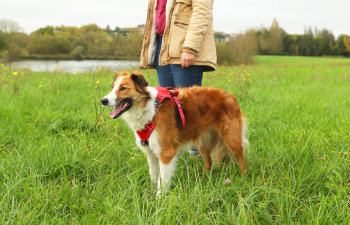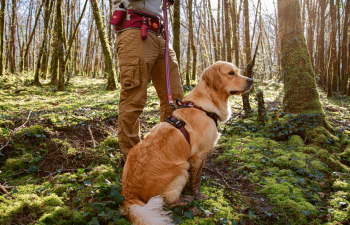
My dog barks at home
This is one of the most common complaints. A neighbour passes your apartment on the landing, a knock at the door… in short, your dog barks at the slightest noise, and however hard you try to tell him to stop, he starts again at the slightest opportunity. Nonetheless, it is a legal requirement to control excessive barking. Here is a simple four-point method to rebuild good relations with your neighbours.
1- Understanding your dog’s behaviour:
There are numerous reasons why dogs bark: barking to guard and defend their territory, protective or playful barking, or barking due to fear, stress, excitement or aggressiveness. The list goes on, and you must have noticed that your dog’s tone, volume and way of barking changes according to the context. The reason is very simple: barking is a natural means of communication.
And therein lies the problem. Most of the time, dog training involves either teaching your dog a new action (walking on a lead for example), or correcting abnormal behaviour (urinating in his resting or feeding zone). Now, this involves prohibiting a normal behaviour. The consequences are therefore logical: the more you attempt to force your dog not to bark, the more frustrated your dog will become, and the more he will bark.
The key is thus to manage your dog’s barking. As paradoxical as it seems, you should start praising your dog as soon as he starts to bark.
2- Choosing the right materials
We cannot emphasise this enough: reward-based training is more effective than punishment. For this purpose, equip yourself with a ball and suitable treats. Do not hesitate to alternate between stroking your dog, giving him biscuits and playing with him.
Personally, I wear a bag on a belt so as to always keep my hands free. The MOOV jogging belt is perfect for longer exercises.

Jogging Belt ref. 466 682
3- Preparing for training
This purpose of this initial step is to reward your dog when he barks, so that he understands that you are pleased with him for doing his “job”.
Identify the most common causes of your dog’s barking (doorbell, footsteps in a neighbouring apartment, people passing in front of a window, etc.), and ask someone to act them out for you. Reward your pet as soon as he starts barking, using preparatory and execution commands (see “My dog pulls on his lead”).
For example: “Médor”, pause (while your dog is barking), “good dog, bark”.
Your dog will therefore learn two things: the meaning of the command “bark” and “my master controls my barking”. Perfectionists can take this exercise even further, so that the dog barks on command. Ask him to sit and tell him to bark without any stimuli (external noises). It is obviously necessary to repeat the exercise several times in order to achieve results.
4- Training
The desired step: limit your dog’s barking. Ask a friend to help you and ask them to repeat the action which will definitely make your dog bark. Repeat the training preparation exercise and, as soon as your dog stops barking, praise him once again, while adding a new command (for example “quiet”).
For example: “Médor”, pause (while your dog is barking), “good dog, bark”, pause, “quiet”. Reward your dog as soon as he quietens.
Do not hesitate to repeat these exercises as often as possible. There is no secret: the more time you spend with your pet, the more he will reward you… with obedience!
Eric Tramson
https://www.erictramson.com/

Eric Tramson, a state-registered dog trainer for more than 20 years, has successfully developed his own method based on training and positive reinforcement, to help you live in harmony with your dog and avoid minor day-to-day worries.






